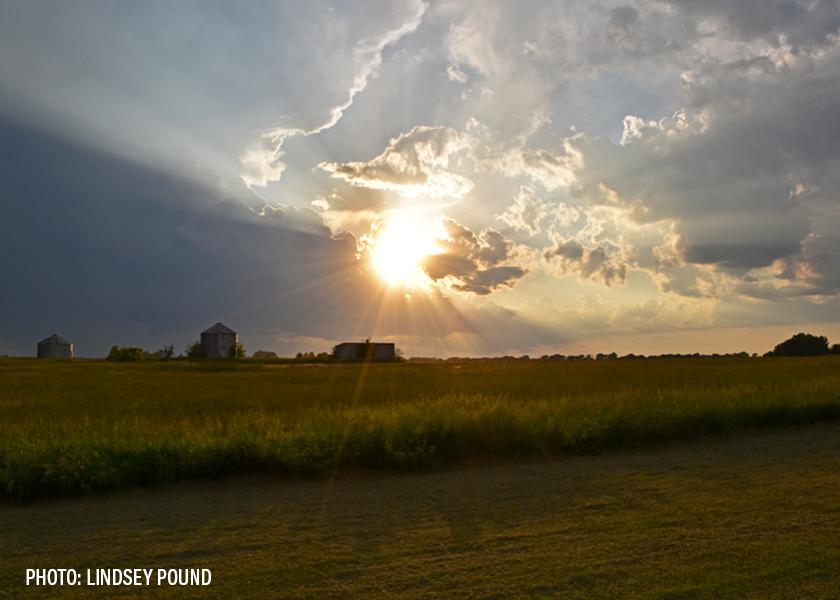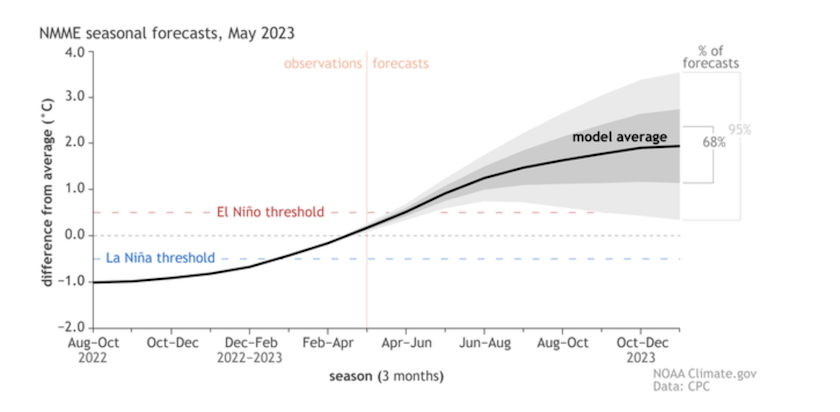U.S. now has a nearly 90% chance of seeing El Niño this summer

La Niña’s punishing drought left scars that will be etched in the minds of farmers in the West and Plains for years to come. As El Niño looks to make its grand return, significant weather changes could be on deck for U.S. farmers this year.
USDA’s May crop production forecast already incorporated some of the positive weather developments, penciling in record national yields of 181.5 bu. per acre for corn yield and 52 bu. per acre on soybeans.
“The thing you've got to remember about the new crop balance sheet is that everything in all of the new crop balance sheets is contingent on weather,” said Joe Vaclavik of Standard Grain. “USDA is assuming normal or favorable weather in regard to crop production.”

The biggest change is El Niño, which is associated with a band of warm ocean water that develops in the central and east-central equatorial Pacific. Forecasters at NOAA are watching the weather transition closely, and watching the timing of when the full weather development will hit the U.S.
"The signs of El Niño development that we saw last month have only grown stronger this month," NOAA said in a blog post this week. "Additionally, we’ve pushed one more month through the dreaded spring predictability barrier. Taken together, these signals have allowed forecasters to increase their forecast confidence this month, with the likelihood of El Niño approaching 90% by summer and exceeding 90% through next fall and winter."

NOAA says the April average sea surface temperature in the Niño-3.4 region, which is the primary monitoring region for ENSO, was 0.1 degrees Celsius above the long-term average, which covers 1991-2020. NOAA says that value is up 0.2 degrees Celsius from March and is the first time the monthly Niño-3.4 temperature was warmer than average since April of 2020.
While most headlines highlight how it can bring historic heat around the globe, agricultural meteorologist Eric Snodgrass says it also tends to bring favorable growing conditions for crops in the Midwest.
“Should it manifest itself and be the most dominant, what we call teleconnection in the pattern, we would likely be seeing a better year overall,” said Snodgrass, the Principal Atmospheric Scientist with Nutrien Ag Solutions.
Will the summer weather be like any other in history? Drew Lerner, founder and president of World Weather, cautions farmers to be careful, because it all depends on timing.
“The El Niño for 2023 will be developing and not established which is why we [World Weather, Inc.] believe the drier bias may be farther to the west in the Midwest this year due to the strong influence of negative PDO and the more underdeveloped influence from El Niño,” he said.

As El Niño continues to creep into the picture, Snodgrass says El Niño summers tend to produce strong crop yields.
“Since 1970, we've had 17 El Niño summers and 14 of them had trendline yields slightly above that. This means we generally think of El Niño summers of having a more juicy atmosphere, or more stuff for thunderstorms, so we'll keep a close eye on it,” he says.
That greenhouse-like growing weather won’t be the case across the U.S. Lerner says the summer will likely have a warmer and drier bias across the Plains, the western Corn Belt and into the Great Lakes region.
“Shots of cooler air will move through the eastern Midwest in late May, late June and late August. The west may cool down for a little while, but it should heat back up faster than the eastern Midwest,” says Lerner. “The northern Plains will be wetter biased in the balance of May and early June with the wetter bias shifting to the west and north during July and August. That should favor Montana, western and northern Dakota and areas to the north. The southern Plains (favoring Texas) will be a little wetter biased in late May and early June and again during August and September.”
Lerner said the states he’s most worried about in terms of summer moisture are Iowa, Missouri, Nebraska and Kansas He thinks the best chance of moisture could fall across northern Plains, upper Midwest and eastern most corn belt, the southeastern states, the lower Delta, Texas and a part of southern Oklahoma.
“There is a strong association with abating multi-year La Niña events that occur in this solar cycle with negative Pacific Decadal Oscillation (PDO) with below average Midwest precipitation,” Lerner said. “This trend tends to occur in most spring seasons when these conditions have been present. However, the bias tends to be more significant in the central and eastern Midwest than in the western Midwest. Western Midwest weather tends to be wetter in these years than areas farther to the east and we are likely to see a short-term increase in western Midwest precipitation in the balance of May until the summer ridge evolves and begins to prevail.”







